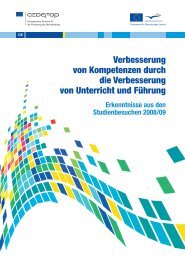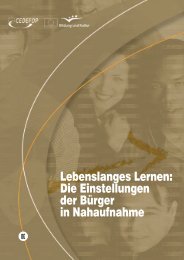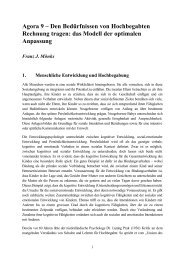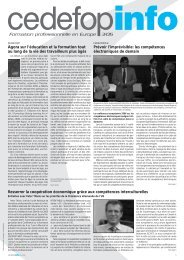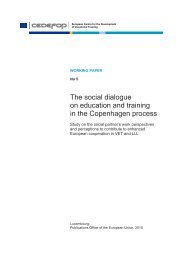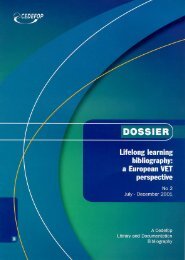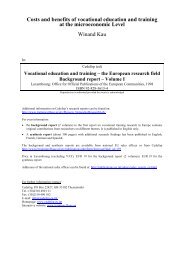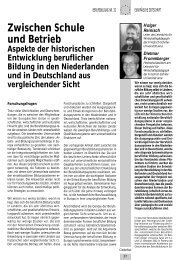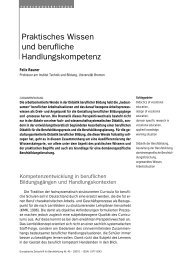Full text (pdf) - Cedefop - Europa
Full text (pdf) - Cedefop - Europa
Full text (pdf) - Cedefop - Europa
Create successful ePaper yourself
Turn your PDF publications into a flip-book with our unique Google optimized e-Paper software.
200<br />
European journal of vocational training<br />
No 42/43 – 2007/3 2008/1<br />
ity), yet they differ in terms of their fields of application. Neither the design phase<br />
nor the final implementation is complete in any one of them: this aspect is undoubtedly<br />
novel. We are dealing here with evolutionary elements of a European<br />
education area, which is itself in the process of taking shape and must<br />
hold its ground against other education areas. The Bologna Process, with its<br />
extensive strategy of development and recruitment of new members, is evidently<br />
pursuing the goal of international coexistence and taking up a clear position<br />
in the con<strong>text</strong> of the GATS (General Agreement on Trade in Services)<br />
negotiations. The Copenhagen Process, for its part, is following more of an<br />
intensive line of development: individual instruments (including ECVET, CQAF,<br />
<strong>Europa</strong>ss and EQF) are being finetuned and harmonised with one another.<br />
It would furthermore appear sensible and necessary in the long term for<br />
the ECVET system to be merged with the ECTS system into an integrated,<br />
coherent overall system with a clear connection to the proposed European<br />
Qualifications Framework. The current challenge lies not so much in extending<br />
the credit system from a function of transfer to one of accumulation, or in<br />
firming up the calculation basis for credits, as might appear to be the case at<br />
first sight from a comparison of ECTS and ECVET. Rather, it lies in the related<br />
issue of how to apply credit systems in conjunction with procedures for<br />
the accreditation and validation of formally, non-formally and informally acquired<br />
learning outcomes and in particular occupational competence. The consequent<br />
permeability between education sectors requires a rethink of access<br />
to, and accreditation or validation of, VET and higher education study programmes.<br />
One key goal in terms of accreditation is to make lifelong learning<br />
a reality between and within national educational and labour markets. Further<br />
integrated development of credit systems from a transfer to an accumulation<br />
function, as well as from an input-based to an outcome related orientation,<br />
could help to build bridges in this area, so that the European Qualifications<br />
Framework can serve as a medium for the integration of general, higher and<br />
vocational education.<br />
Over and above these long-term aims of ECVET, ECTS and EQF, and indeed<br />
of the European education area, attention should be paid to devising<br />
precise and consistent terminology at the level of discourse, because the somewhat<br />
Babylonian linguistic confusion of the official documents tends to lose<br />
sight of the end user, i.e. the learner. We nevertheless have every hope that,<br />
as has been said, ‘the difference in wording is not expected to lead to differences<br />
in implementation’ (European Commission, 2006c, p. 3).




